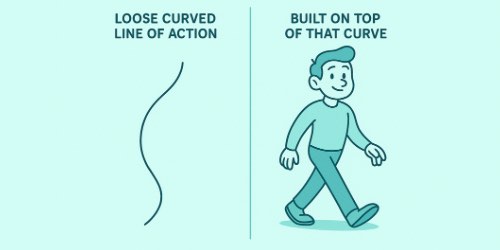What Is the Line of Action?
The line of action is the invisible curve running through a pose that sets its flow, momentum, and attitude. Think of it as the spine of your drawing that unifies the head, torso, and limbs into one coherent idea so the viewer feels the gesture instantly.

Why It Matters in Character Drawing
If your figures look stiff, the culprit is often a weak or missing line of action. A clear line adds movement to still poses, organizes complex forms around a single rhythm, and guides the viewer’s eye cleanly from point A to point B so the character reads in a split second.
How to Find the Line of Action
Train your eye to reduce any pose to one simple stroke that captures its energy before adding forms.
- Squint at a photo or live pose to ignore details and feel the main sweep of the body.
- Lay a single curve through the figure first, then hang shapes on that wireframe.
- Push the curve a little farther than reality to heighten clarity and intent.
This sequence keeps you designing the pose rather than copying parts, which makes your drawings feel alive.

Common Mistakes to Avoid
- No central idea: Jumping to details without a guiding curve creates stiff, competing shapes.
- Over‑complicated strokes: A line of action should be a simple, readable gesture rather than a zigzag maze.
- Half‑commitment: If the curve is timid, the pose looks unsure; commit to the sweep you want the viewer to feel.
Avoiding these pitfalls preserves clarity and keeps your characters readable from thumbnail distance.
Practice Routines That Work
Set a timer for 30–60 seconds and do gesture pages using only a single stroke per pose, then build simple forms on top. Repeat with sports photos, film stills, or your own mirror poses so you internalize how weight and direction flow through a body over time.
For structured fundamentals that pair well with gesture, browse the drawing tracks at Artist School and map one short lesson to each sketch session so practice stays consistent.
Want a beginner‑friendly path that reinforces gesture and clarity without overwhelming you?
Final Thoughts
Mastering the line of action is a small habit with a huge payoff, because one confident curve sets up stronger poses, cleaner storytelling, and characters that feel truly alive.




























